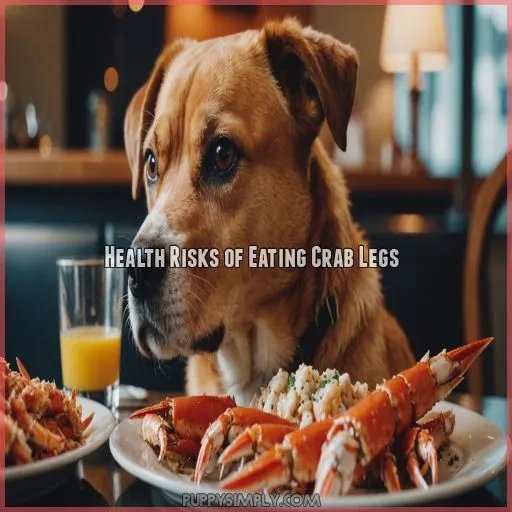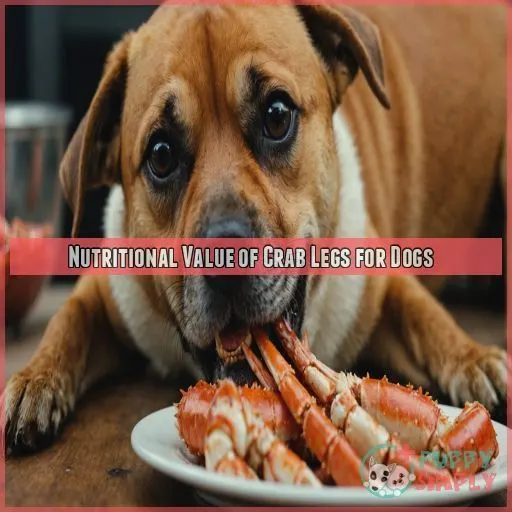This site is supported by our readers. We may earn a commission, at no cost to you, if you purchase through links.
 Dogs can eat crab legs, but like a suspicious mother-in-law, you need to be cautious!
Dogs can eat crab legs, but like a suspicious mother-in-law, you need to be cautious!
Cooked crab meat can be a delicious treat packed with protein, but make sure to ditch those sharp, pesky shells to avoid a canine choking hazard.
Think of crab legs as a fancy appetizer, not the main course; moderation is the key due to high sodium.
And if your furry friend starts itching or sporting tummy troubles, they might be allergic.
Why not try a little crab adventure with your pup, shell-free and safe?
Curious about more delicious yet safe seafood options for your pooch? Read on!
Table Of Contents
- Key Takeaways
- Can Dogs Eat Crab Legs
- Health Risks of Eating Crab Legs
- Safely Feeding Crab Legs to Dogs
- Nutritional Value of Crab Legs for Dogs
- Dog Reactions to Eating Crab Legs
- Removing Shell and Seasonings for Dogs
- Popular Crab-Based Treats and Substitutes
- Consequences of Consuming Crab Shells
- Commercial and Frozen Crab-Based Options
- Why Feeding Your Dog Raw Crab Isn’t Ideal
- Frequently Asked Questions (FAQs)
- What happens if my dog eats crab legs?
- Can dogs eat shrimp or crab?
- Are crabs poisonous to dogs?
- Can a dog eat crab sticks?
- How often can dogs eat crab legs?
- Are there specific breeds sensitive to crab?
- Can puppies safely consume crab meat?
- Does crab leg consumption affect dog weight?
- Is crab leg meat beneficial for aging dogs?
- Conclusion
Key Takeaways
- Make sure you always remove crab shells completely before sharing with your dog; think of it like keeping your pup away from a pile of sharp Lego pieces. Shells are just sneaky ninjas waiting to cause problems.
- Keep portions small and infrequent; remember, crab legs are akin to a fancy dessert for dogs. Too much could lead to unwanted tummy troubles or weight gain, so moderation is your friend.
- Watch for allergic reactions like itching or stomach upset. If your dog starts doing an impersonation of a cat with itchy paws, pull back on the crustacean at once.
- Always cook crab legs thoroughly and skip any seasoning. You wouldn’t want an unwelcome guest like a parasite showing up in your dog’s stomach, so make sure those crab legs are cooked to perfection.
Can Dogs Eat Crab Legs
Wondering if you can share your seafood feast with your furry companion?
While crab legs aren’t toxic to dogs, you’ll need to be cautious to make sure they enjoy this seaside treat safely.
Are Crab Legs Toxic to Dogs
While crab legs aren’t inherently toxic to dogs, you’ll want to tread carefully.
Cooked crab meat can be a tasty treat, but the sharp shells pose a serious choking hazard.
And raw crab may harbor nasty parasites that could make your pup sick.
Benefits and Risks of Crab Legs
Crab legs can be tempting treats for your pup, packed with omega-3 fatty acids and protein.
But, be careful!
The risk of shell dangers and dog allergies is real.
Always choose cooked over raw crab legs to avoid parasites.
Think of crab shells as tiny ninjas threatening your dog’s gut health.
So, if you’re serving crab legs, make sure they’re shell-free!
Crab Legs and Canine Nutrition
You’re probably wondering if it’s okay to give your furry friend crab legs.
It’s important to remember that while crab legs can be a good source of lean protein and essential nutrients, they can also pose some risks.
For example, some dogs might be allergic to crab, and others might have trouble digesting it.
If you do decide to give your dog crab legs, make sure to keep the servings small and simple.
This will help ensure that the crab meat benefits your dog’s diet without causing any tummy troubles.
You might also consider making your own crab treats at home.
Health Risks of Eating Crab Legs
Feeding crab legs to your dog might sound like a fancy treat, but it’s not without risks.
It’s important to understand these health risks for your dog’s safety, especially if you’re considering feeding them kidney beans.
From shell pieces that are likely to get stuck in your pup’s intestines to unexpected allergic reactions, there are several potential dangers.
Intestinal Blockage From Shell Pieces
Crab shells can pose a serious choking and intestinal blockage risk for your pup.
Larger shell fragments may get stuck, causing painful obstructions that require emergency vet care.
To prevent this:
- Thoroughly remove all shell pieces before serving crab.
- Opt for smaller breeds or monitor closely if feeding crab.
- Watch for signs of distress and contact your vet immediately if you suspect a blockage.
Allergic Reactions and Food Poisoning
When sharing crab legs with your furry friend, beware of allergic reactions and food poisoning.
Some dogs are as sensitive as a picky eater at a buffet.
Watch for symptoms like itchy skin or tummy troubles.
For pet safety, consult your vet if symptoms arise.
There are safer crab substitutes and dog treats that may better suit your pup’s discerning taste buds.
Parasites in Raw Crab Legs
Raw crab legs can harbor sneaky parasites like lung fluke, which aren’t good party guests in your pooch’s tummy.
Parasite prevention is key in seafood safety.
Always cook those crab legs thoroughly to make sure your dog’s dining experience doesn’t turn into a health risk.
Keep your furry friend’s tail wagging with safe, thoroughly-cooked treats!
Excessive Sodium and Cholesterol
After wrangling the pesky parasites, it’s time to address another concern: sodium and cholesterol.
These can sneak up on you, especially with crab legs.
Too much sodium impacts heart health, causing high blood pressure in your pooch, while cholesterol concerns might require diet modifications.
Consider treat alternatives or consult quality dog food brands to keep Fido’s tail wagging happily!
Safely Feeding Crab Legs to Dogs
If you decide to treat your pup to some crab, there are a few important steps to follow for safe feeding.
Make sure to thoroughly cook and remove all traces of the sharp, indigestible shells before offering this tasty seafood snack.
Preparing and Cooking Crab Legs
- Steam crab legs to help soften the shell, making removal easier.
- Remove shells carefully to prevent accidents.
- Skip the garlic and serve plain for your pet.
- Cook thoroughly to kill harmful bacteria.
Now, your dog can enjoy that meal safely!
Serving Sizes for Different Breeds
Serving crab legs to your furry friend should be based on breed and weight.
Puppies need a pinch, while large breeds might enjoy a tablespoon.
Think of it like portion control with human desserts!
Too much can upset their tummy, so follow dog food advice carefully.
Avoiding Imitation Crab and Shell Fragments
If you’re thinking about giving your dog crab, steer clear of imitation varieties.
They’re packed with questionable ingredients that can upset your pup’s tummy.
And watch out for those pesky shell fragments, which can pose a serious choking hazard or cause intestinal blockages.
Stick to plain, fully-cooked crab meat and always consult your vet if you have any concerns.
Nutritional Value of Crab Legs for Dogs
Crab legs can offer your dog valuable nutrients like protein, zinc, and omega-3 fatty acids.
However, don’t let your pooch get too shellfish; small portions are best.
While they may seem like a fancy feast, remember that crab legs are also high in sodium and iodine, so it’s important to balance their introduction carefully into your furry friend’s diet.
High-Protein Content and Essential Vitamins
Crab can be a tempting treat for your dog because of its high protein content and essential vitamins.
It’s like a fairy godmother blessing your pup’s nutrition, but remember, moderation is key.
Just like sprinkling fairy dust, keep it balanced to ensure a happy, healthy tail wag.
Rich Source of Zinc, Omega-3, and Iodine
Packed with zinc, omega-3, and iodine, crab legs can benefit your pup if handled with care.
Picture your dog as a canine connoisseur, savoring small amounts of this nutrient-dense treat.
Just remember:
- Limit portions for safety.
- Be cautious of allergies.
- Check with your vet.
- Avoid crab shells altogether.
Even dog food aficionados approve, but always prioritize safety!
Crab Legs Vs Other Protein-Rich Treats
While crab legs offer a tasty protein boost, they’re not the only game in town.
Chicken, fish, and lean meats pack a similar nutritional punch without the high sodium and cholesterol.
And don’t forget about dog-friendly fruits, veggies, and dairy treats like yogurt – they’re packed with vitamins and minerals your pup will love.
| Protein Source | Protein | Sodium | Cholesterol |
|---|---|---|---|
| Crab Legs | High | High | High |
| Chicken | High | Low | Low |
| Fish | High | Low | Low |
| Beef | High | Medium | High |
| Peanut Butter | Medium | Low | Low |
| Yogurt | Medium | Low | Low |
Dog Reactions to Eating Crab Legs
If you’re planning on treating your dog to crab legs, be aware they might not share your love for seafood.
Dogs can have mild reactions or more severe ones like anaphylaxis.
So, it’s wise to monitor them closely and be ready to call the vet if you notice anything fishy.
Mild Reactions, Severe Reactions, and Anaphylaxis
Your furry pal might love crab legs, but be cautious—some dogs react poorly.
Keep an eye out for signs of allergies, from mild itchiness to severe reactions like anaphylaxis.
If your dog is a sneezy breed with food allergies, they’re more at risk.
Identifying triggers and avoiding them in their future meals is key.
Your dog food aficionado thanks you!
Gastrointestinal Upset, Diarrhea, and Vomiting
Crab legs can cause mild to severe reactions in dogs, leading to symptoms like gastrointestinal upset, diarrhea, and vomiting.
To keep your furry friend safe from dog food sensitivities and dietary triggers, consider these options: looking for safe alternatives
- Homemade dog food: This gives you complete control over ingredients.
- Gut health monitoring: Keep an eye out for any changes in your dog’s digestion.
- Probiotics: These can help support a healthy gut microbiome.
- Consult dog food masters: Talk to a veterinarian or certified canine nutritionist for personalized advice.
Emergency Vet Care and Allergic Testing
If your dog has a severe reaction after eating crab, like difficulty breathing or swelling, rush them to the vet immediately.
They may need emergency treatment for anaphylaxis.
Your vet can also perform allergy testing to determine if your pup has a shellfish sensitivity and should avoid crab in the future.
Better safe than sorry!
Removing Shell and Seasonings for Dogs
When feeding crab legs to your dog, you’ll need to master the art of shell removal and seasoning control.
This ensures a safe and tasty treat for your pup.
It’s a bit like a surgeon and a chef teaming up in the kitchen, with a goal of protecting your pup from sharp shells and spicy surprises.
Steaming Vs Boiling to Reduce Shells
Considering crab shells could turn mealtime into gravel munching, opting for steaming or boiling crab legs is wise.
Both cooking methods soften the shell texture, safeguarding your dog’s dining experience.
Steaming retains more nutrient retention, making it a dog food gourmet choice.
Meanwhile, boiling often enhances flavor impact.
Removing all shells guarantees an epicurean adventure, not a crunchy surprise!
Homemade Seasoning Options and Spice Control
Want to whip up a homemade crab dip for your furry food connoisseur?
Stick to dog-safe spices like parsley and turmeric for a sophisticated twist on dog food gastronomy.
Avoid high-risk seasonings like onion or garlic.
Keep spice level control in check.
After all, your pup deserves luxury dining without risking spice drama!
Maintaining Quality Control When Cooking Crab
When cooking crab for your pup, quality control is key. Thoroughly remove all shells – even tiny fragments can pose a choking hazard. Opt for simple seasonings like garlic powder or lemon juice, avoiding anything too salty or spicy. Check the crab’s freshness, and cook it thoroughly to kill any potential parasites. Your dog’s safety comes first!
Here’s a quick checklist to keep in mind:
- Carefully remove all shell pieces.
- Use mild, dog-friendly seasonings.
- Make sure the crab is fresh and fully cooked.
- Monitor temperature to kill parasites.
- Prioritize your pup’s wellbeing.
Popular Crab-Based Treats and Substitutes
When you’re exploring treats for your pup, crab-based options might catch your eye.
But they’re not the only choice.
Discover safe alternatives packed with iodine, zinc, and protein to keep your furry friend’s tail wagging without the risk of a shellfish snafu!
Alternative Sources of Iodine, Zinc, and Protein
When looking for alternatives to crab in dog food, consider fish oil supplements, beef liver, and spinach.
These ingredients are packed with essential nutrients like iodine and zinc.
Eggs and bone broth are also excellent choices for canine nutrition.
Balancing Diets and Whole-Food Meals
Crafting a balanced diet for your dog can feel like walking a culinary tightrope.
You don’t need to go all raw food diet or blow your budget on commercial dog food.
Explore nutrient-rich whole foods and consider homemade dog food for nutritional balance.
When asking "can dogs eat crab legs?" treat moderation is key—it’s all about balance!
Recommendations From Dog Food and Veterinary Professionals
You must be thinking about safe crab feeding for your furry friend.
Experts have several vet-approved treats that could do the trick:
- Dog food brands: Offering specialized formulas.
- Pet food safety: It’s paramount, so always read labels.
- Crab allergy risks: Be cautious with new treats.
Stay mindful, and remember, a well-balanced diet keeps tails wagging!
Consequences of Consuming Crab Shells
Crab shells can be a crunchy danger for your dog, like stepping barefoot on Legos!
Their sharp edges and shapes might lead to serious blockages or injuries.
Let’s explore how to keep your pup safe and sound.
How Crab Shell Shapes Pose Risks
Remember that crab-based treats should be safe and enjoyable.
So let’s shell out some wisdom: crab shell shapes can pose risks! They might look funny, but those sharp edges can cause choking hazards and intestinal blockage.
No dog needs that kind of trouble!
Here’s a breakdown of the potential risks:
| Risk | Description | Outcome |
|---|---|---|
| Choking Hazard | Sharp edges block the airway | Difficulty breathing |
| Intestinal Blockage | Shell fragments get stuck in the intestines | Painful digestion |
| Digestion Issue | Hard to break down | Stomach upset |
X-ray Scans, Gastroscopy, and Urgent Medical Treatment
If your curious canine manages to crunch down on a crab shell, don’t panic – but do act quickly.
Seeking prompt veterinary care is vital to protect your pup’s wellbeing.
Your vet may recommend:
- X-ray scans to check for internal blockages
- Gastroscopy to visually inspect the digestive tract
- Urgent medical treatment to safely remove any obstructions
- Close monitoring for signs of intestinal distress
Protecting Intestinal Walls From Blockage and Obstruction
Your dog’s guts shouldn’t play a shell game!
Protecting those intestinal walls starts with shell removal tips, emphasizing a thorough check for lingering pieces.
Think of crab shells as sneaky villains in a superhero movie – eliminate them to prevent blockage.
Opt for safe crab serving and keep digestive health risks at bay.
Dog-safe crab prep can help make sure a wagging tail, not vet visits.
Commercial and Frozen Crab-Based Options
When considering commercial and frozen crab-based options for your canine buddy, it’s really important to check the shelf-life and ingredient labels carefully.
Monitoring Shelf-Life, Ingredient Label, and Refrigeration
Checking shelf-life and ingredient labels is as important as checking your dog’s mischief levels.
Watch for freshness when buying commercial crab.
Proper storage, like refrigerating or freezing, keeps the food safe.
No one wants a seafood surprise, and dogs aren’t too thrilled about tummy troubles either.
Treat crab legs like you treat leftovers – lovingly stored, never ignored!
Artificial Flavors and High Sodium Concerns
Beware of those fancy commercial crab treats.
They may be packed with artificial flavors and high sodium levels that can upset your pup’s tummy.
Instead, opt for sodium-free, natural crab options or look into grilled crab as a healthier alternative.
Your dog’s taste buds (and digestive system) will thank you!
Exploring Additional Raw Materials, Grilled Treats
After considering sodium concerns, let’s talk variety!
Why not try grilled salmon or baked chicken?
They’re delicious and often easier on your dog’s tummy than crab legs.
Beef jerky, cooked shrimp, and pork ribs are also fun snacks.
Just make sure they’re plain and dog-friendly.
Why Feeding Your Dog Raw Crab Isn’t Ideal
Feeding your dog raw crab isn’t the best idea unless you’re a fan of surprise vet visits!
Raw crab can pose serious risks, like bacterial food poisoning and digestive trouble from shell bits.
Stick to cooked varieties to keep your pup safe and happy.
Serious Risk Factors Associated With Eating Raw Seafood
Your furry friend’s idea of gourmet shouldn’t include raw seafood.
Feeding raw crab risks a parasite infection, like a woof-sized tapeworm hotel, and Vibrio bacteria that spell trouble faster than you can say "Salmonella poisoning."
Shell ingestion also poses a foodborne illness hazard.
So, roll up your sleeves, cook that crab fully, and prevent a shell of a problem!
Causes and Incidences of Canine Bacterial Food Poisoning
Raw crab can be dangerous for dogs.
Bacteria like Salmonella and Vibrio can cause food poisoning.
Symptoms of food poisoning in dogs include vomiting, diarrhea, and lethargy.
To avoid food poisoning, stick to fully cooked crab.
Digestive Strain of Removing Crabs Shell Membranes
Imagine this: the digestive equivalent of you chewing on rocks. To keep your dog’s intestinal health in check, avoid raw crab.
Instead, focus on safe handling with these shell removal techniques:
- Steam the meat to soften membranes.
- Remove all shell fragments.
- Check for sharp bits.
- Cook thoroughly to prevent digestive issues.
It’s a shell game worth winning!
Frequently Asked Questions (FAQs)
What happens if my dog eats crab legs?
If your pup is a crab cake connoisseur, don’t panic.
Just keep a watchful eye.
Those sharp shells could spell trouble, so it’s best to steer clear of letting them indulge in the whole crustacean.
Can dogs eat shrimp or crab?
Yes, dogs can enjoy shrimp and crab if they are thoroughly cooked and given in moderation.
Make sure to remove shells to avoid choking hazards.
Keep an eye out for any allergic reactions or discomfort.
Are crabs poisonous to dogs?
Imagine your dog as a pirate sniffing out forbidden treasure.
While crabs aren’t poisonous, their shells can be sharp stumbling blocks.
Like stepping on Lego bricks, they could hurt your pup.
Better to skip those crunchy bits!
Can a dog eat crab sticks?
Crab sticks aren’t the real deal for your pup.
They’re more like a soggy imitation.
Loaded with additives and sodium, they might give your doggie’s belly the blues.
Stick to safer snacks and avoid a veterinary nightmare!
How often can dogs eat crab legs?
Whoa there, pup parent!
While a nibble of cooked crab leg here and there won’t hurt your canine companion, it’s best to keep those crustacean treats to a minimum.
Stick to small, infrequent servings to avoid any tummy troubles or other health issues.
Are there specific breeds sensitive to crab?
While some dogs might be more sensitive, there’s no specific breed known for crab allergies.
It’s important to keep an eye out for any odd behavior, like tummy troubles or itching.
When in doubt, chat with your vet!
Can puppies safely consume crab meat?
You might think it’s a small problem, but puppies can enjoy small amounts of cooked crab meat!
Just make sure it’s shell-free and monitor for reactions.
Always chat with your vet to keep tails wagging safely.
Does crab leg consumption affect dog weight?
If your dog indulges in crab legs, it could lead to weight gain.
This is due to the high cholesterol and sodium content in crab legs.
So, it’s best to keep those crab cravings in check and opt for healthier protein sources instead.
Is crab leg meat beneficial for aging dogs?
Crab leg meat can provide a tasty treat.
However, it’s best to tread carefully with aging pups.
The high sodium and cholesterol could put strain on their delicate systems.
Stick to vet-approved snacks to keep your senior sidekick happy and healthy.
Conclusion
Feeding your dog crab legs is like introducing a new hobby: start slowly, observe closely, and proceed with care.
While crab legs can offer protein and vitamins, they also bring risks.
Avoid raw crab and pesky shells, which resemble tiny ninja stars that can wreak havoc on your pup’s digestive system.
Keep an eye out for allergies or stomach issues.
If you’re still pondering, "Can dogs eat crab legs?" the answer is yes, they can, but moderation and vigilance are key.















